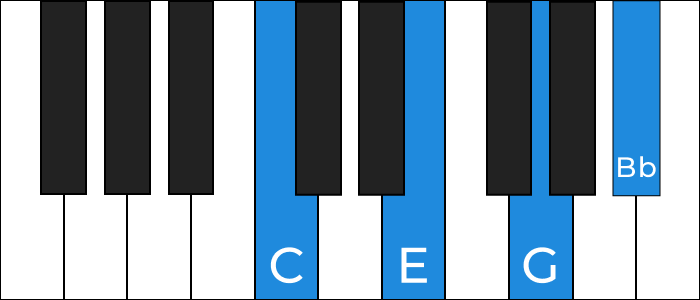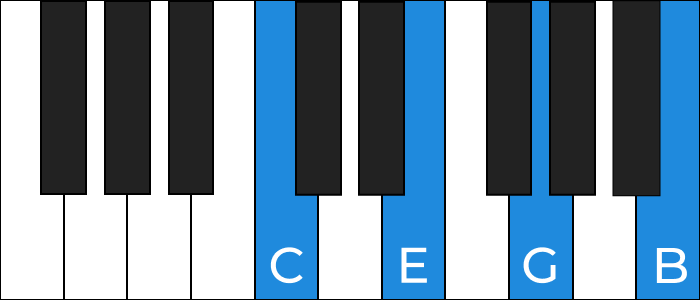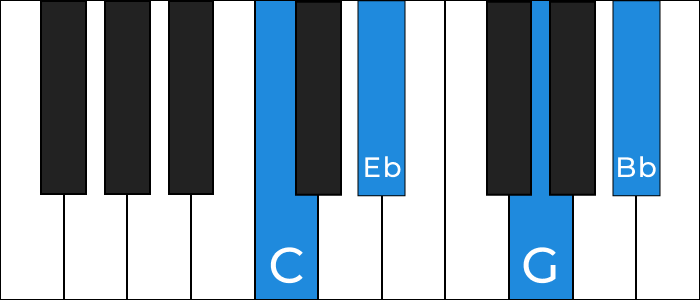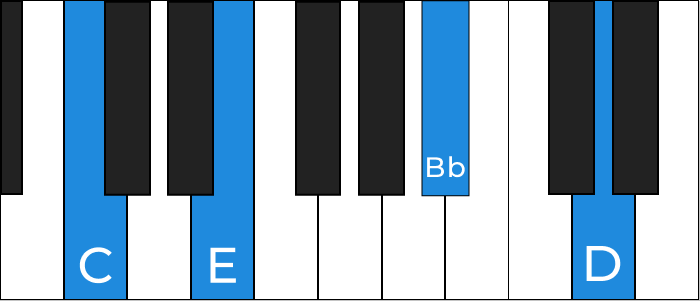Chords are the foundation of songwriting. We can use chords and chord progressions to set the tone for an entire song. If you haven’t already, check out our article on the basics of chord building.
There’s nothing wrong with writing songs using only triads (major, minor, diminished, and augmented chords). Many popular songs stick to a handful of common triads.
However, by adding extra notes to triads, you can add a rich layer to your song that might just take it to another level.
Seventh Chords
The most common note to add to a triad is a seventh. This creates a seventh chord, which can add a beautiful, and often jazzy, sound to your song.
Let’s talk about the three most common seventh chords: Dominant Seventh, Major Seventh, and Minor Seventh.
Dominant Seventh
Dominant Seventh chords are very common in blues music. They are often used to drive a piece toward a resolution.
If you see a chord like C7, it is commonly assumed that this is a C Dominant Seventh chord. We build our C Dominant Seventh chord by building a C Major triad and adding a minor seventh (+10 semitones from the root).
To build a C7 chord, we start with the root, a C. Then, we add 4 semitones for the major third, an E. We’ll add 3 more semitones for our perfect fifth, a G. Then, we’ll add 3 more semitones (10 semitones from the root) for our minor seventh, a Bb. So, our C Dominant Seventh chord is C - E - G - Bb.

Major Seventh
Major Seventh chords are common in jazz. They bring a beautifully soft and laid back feeling to a piece.
We build our C Major Seventh chord (CMaj7) by building a C Major triad and adding a major seventh (+11 semitones from the root).
To build a CMaj7 chord, we start with the root, a C. Then, we add 4 semitones for the major third, an E. We’ll add 3 more semitones for our perfect fifth, a G. Then, we’ll add 4 more semitones (11 semitones from the root) for our major seventh, a Bb. So, our C Major Seventh chord is C - E - G - B.

Minor Seventh
Minor Seventh chords are also very common in jazz, and they play very nicely with Major Seventh chords.
To build a Cm7 chord, we start with the root, a C. Then, we add 3 semitones for the minor third, an Eb. We’ll add 4 more semitones for our perfect fifth, a G. Then, we’ll add 3 more semitones (10 semitones from the root) for our minor seventh, a Bb. So, our C Dominant Seventh chord is C - Eb - G - Bb.

Extended Chords
There are many ways to add notes to our chords to make them more interesting. We call a chord extended if it includes notes added beyond the seventh.
Extended chords include ninth, eleventh, and thirteenth chords. When we build a true extended chord, it is expected that we pick up every third along the way. This means that an eleventh chord (e.g. CMaj11) includes a root, a third, a fifth, a seventh, a ninth, and an eleventh.
As you might imagine, these chords can get pretty complicated pretty fast. In practice, extended chords almost always omit some of these notes, especially the fifth.
Let’s take a look at how we would build one extended chord: the dominant ninth.
Dominant Ninth
A Dominant Ninth chord is made up of a root, a major third, perfect fifth, minor seventh, and major ninth.
To build a C9 chord, we’ll start with C, our root note. Then, we’ll add 4 semitones to find the major third, an E. We’ll add 3 more semitones to find the perfect fifth, a G. 3 more semitones give us our minor seventh, a Bb.
At this point, we’ve built a C7, which we talked about above. It’s easy to build a Dominant Ninth chord by starting with a Dominant Seventh chord.
Finally, we add 4 more semitones for our major ninth, a D. So, we have our C9 chord: C - E - (G) - Bb - D.
When you see a note in parenthesis, that note is often omitted from the chord. In this case, a C9 will often be played without its fifth.
On the piano, this would look like:

Explore other extended chords!
There are many other ways to extend chords. Take some time to play around with 9th, 11th, and 13th chords. Eventually, these chords will be second nature and you can apply them to your songs to create some really great sounds.
Ready to jump into songwriting feet-first?
Check out Songcraft, our all-in-one songwriting platform that will help you explore chords and put together the perfect chord progression.
Happy songwriting!
